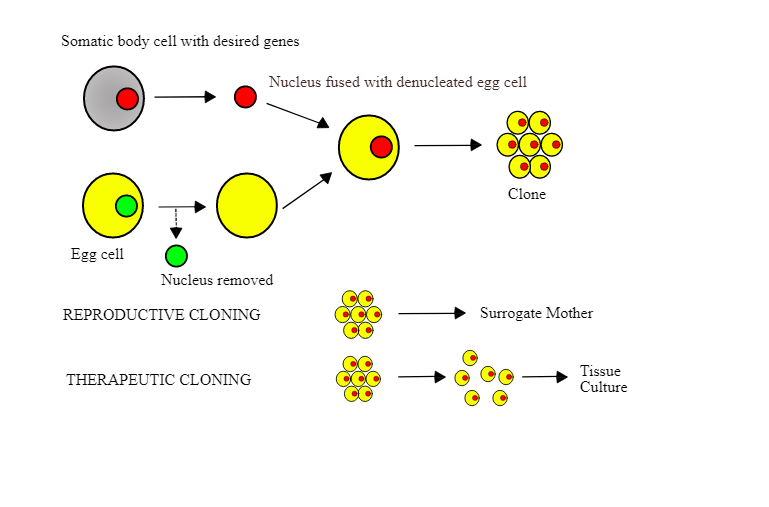
Draw a flowchart to show the process of cloning.
Answer
567k+ views
Hint: In biotechnology, cloning is a process of creating clones (exact copies of parents) of organisms, copies of cells or DNA (deoxyribo nucleic acid) fragments. The term clone is derived from ancient work. The term clone was coined by Herbert J. Webber.
Complete answer:
Types of the cloning:
There are two types of cloning-
1.Reproductive cloning – Reproductive cloning involves the implantation of a cloned embryo in the uterus of a surrogate mother. The embryo develops into the fetus.
2.Therapeutic cloning – Therapeutic cloning is used to clone embryos for the purpose of extracting stem cells from them. In therapeutic cloning, the cloned embryo is not implanted into the uterus of the surrogate mother.

Process of cloning:
1.First the nucleus is isolated from the somatic cell (cells of the whole body) of an organism.
2.The nucleus of the egg cell is removed in order to make it enucleated (without nucleus).
3.The nucleus of the somatic cell is transplanted into the enucleated egg cell in order to make a clone..
4.In reproductive cloning, this cloned egg cell is transplanted to the uterus of the surrogate mother.
5.In therapeutic cloning the cloned egg cell grows artificially.
Note: With the help of the reproductive cloning, Ian Wilmut and his colleagues make a sheep whose name is Dolly sheep. The newly cloned egg cell contains the nucleus of the mammary gland. The Dolly sheep was cloned by fusing the nucleus from a mammary gland of a Finn Dorset ewe into an enucleated egg cell which was taken from a Scottish Blackface ewe.
Complete answer:
Types of the cloning:
There are two types of cloning-
1.Reproductive cloning – Reproductive cloning involves the implantation of a cloned embryo in the uterus of a surrogate mother. The embryo develops into the fetus.
2.Therapeutic cloning – Therapeutic cloning is used to clone embryos for the purpose of extracting stem cells from them. In therapeutic cloning, the cloned embryo is not implanted into the uterus of the surrogate mother.

Process of cloning:
1.First the nucleus is isolated from the somatic cell (cells of the whole body) of an organism.
2.The nucleus of the egg cell is removed in order to make it enucleated (without nucleus).
3.The nucleus of the somatic cell is transplanted into the enucleated egg cell in order to make a clone..
4.In reproductive cloning, this cloned egg cell is transplanted to the uterus of the surrogate mother.
5.In therapeutic cloning the cloned egg cell grows artificially.
Note: With the help of the reproductive cloning, Ian Wilmut and his colleagues make a sheep whose name is Dolly sheep. The newly cloned egg cell contains the nucleus of the mammary gland. The Dolly sheep was cloned by fusing the nucleus from a mammary gland of a Finn Dorset ewe into an enucleated egg cell which was taken from a Scottish Blackface ewe.
Recently Updated Pages
Which cell organelles are present in white blood C class 11 biology CBSE

What is the molecular geometry of BrF4 A square planar class 11 chemistry CBSE

How can you explain that CCl4 has no dipole moment class 11 chemistry CBSE

Which will undergo SN2 reaction fastest among the following class 11 chemistry CBSE

The values of mass m for which the 100 kg block does class 11 physics CBSE

Why are voluntary muscles called striated muscles class 11 biology CBSE

Trending doubts
Which are the Top 10 Largest Countries of the World?

What are the major means of transport Explain each class 12 social science CBSE

Draw a labelled sketch of the human eye class 12 physics CBSE

Draw the diagram showing the germination of pollen class 12 biology CBSE

Differentiate between insitu conservation and exsitu class 12 biology CBSE

The computer jargonwwww stands for Aworld wide web class 12 physics CBSE




